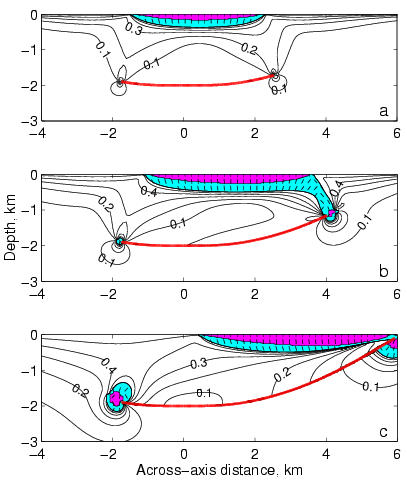Most of the upper oceanic crust at the fast spreading East Pacific Rise (EPR) is accreted in a relatively narrow (several tens to several hundreds of meters wide) neovolcanic zone. While it is generally accepted that the axial neovolcanic zone is the main locus of magmatic construction at the EPR, detailed ocean floor surveys including visual observations from submersibles and rock sampling along the Northern EPR reveal that volcanic activity may sometimes occur several kilometers from the ridge axis. We propose that the off-axis faulting and eruptions may result from episodic emplacement of magma sills (i.e., sub-horizontal sheet intrusions) beneath the ridge axis. While it is well established that magma transport in the upper brittle crust is predominantly sub-vertical and accommodated by dike intrusions, sporadic increases in magma supply to the ridge axis may temporarily overwhelm the far-field extensional stress field imposed by plate separation. In this case, repeated dike injections are expected to reset the least compressive stress in the upper crust from horizontal to vertical, and continued magma supply may favor subsequent magma intrusions in sills. Sills might form in the result of lateral ``break-outs'' of a shallow magma lens, or magma emplacement in horizontal sheets at deeper levels in the crust, as proposed based on ophiolite studies. Because horizontal intrusions may play an important role in accretion of the middle and lower oceanic crust, it is instructive to consider mechanical consequences of magma propagation in sills. Figure on the right shows results of numerical simulation of the sill growth using a boundary element model for an initial emplacement depth of 2 km. |
As one might expect, the sill continues to propagate horizontally as long as its half-length L is small compared to its depth H. For L/H > 1, however, the sill begins to turn toward the surface. Because the free surface amplifies the stress concentration at the crack tip and increases the crack aperture behind the tip, one may anticipate that at this point the sill propagation may become essentially asymmetric (e.g., a statistically longer sill arm is likely to ``win out'' and channel the magma flow along the least resistance path). In the model shown in figure, the left sill tip is ``frozen'' as the intrusion reaches the ratio L/H=1. Continued sill propagation at the other end ultimately results in an ``eruption'' at a distance of about 3 times the initial emplacement depth. Also shown in the figure is inelastic deformation of the host rocks due to excess magma pressure. Contours denote the ratio of shear stress to the effective normal stress (i.e., the difference between the normal stress and the hydrostatic pore pressure) resolved on planes that are optimally oriented for failure. Assuming a Mohr-Coulomb failure envelope, slip on the optimally oriented planes is predicted when this ratio exceeds a coefficient of friction. Shear failure is expected to occur along one of the planes inclined at an angle less than 45 degrees with respect to the maximum compressive stress orientation (see tickmarks in figure). |
|
The modeling results show that sill emplacement may give rise to outward-dipping or nearly-vertical normal faults, given a sufficiently high excess magma pressure. If sill-induced faulting plays a role in the formation of abyssal hills on the East Pacific Rise, the observed throws on the near-axis faults of a few tens of meters might be produced by several generations of sill intrusions. Alternatively, sill-induced faults might be re-activated in the presence of off-axis deviatoric extension (e.g., during periods of decreased magma supply to the ridge axis). The off-axis extension may be a predominant mechanism for the growth of the inward-dipping faults, as evidenced by a continued accumulation of throw on the inward-dipping faults up to several tens of kilometers away from the ridge axis.
Go back |
